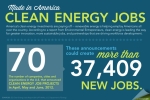Hundreds of thousands of people found work in the past few years thanks to Recovery Act and Energy Department programs designed to stimulate the economy while creating new power sources, conserving resources and aligning the nation to once again lead the global energy economy.
The Energy Department has several tools at its disposal to put Americans to work while pursuing long-term national energy goals like spurring the development of electric vehicles, updating the national power grid, and making commercial buildings more efficient. Tax credits directly fund, among other things, construction and manufacturing jobs to build the facilities and components needed to meet energy goals. Grants fund research into new and innovative ways to generate energy – and the jobs associated with them. Loan guarantees alone have financially backed $40 billion in investments for commercial clean energy projects, giving us a chance to compete and succeed in the global clean energy race.
Manufacturing and clean energy generation
BrightSource Ivanpah solar energy complex in the Mojave Desert is expected to create about 1,000 construction jobs and, once completed, will create more than 80 permanent positions to maintain the facility. Other companies like A123 Systems and Waukesha Electric used Recovery Act tax credits and grants to expand their operations and create 1,250 jobs.
A123 Systems, which makes lithium-ion batteries for electric vehicles, received a tax credit to expand its operation in Michigan. Energy Secretary Steven Chu visited the plant in May to celebrate their one thousandth new hire statewide – a major milestone in building the manufacturing capacity to put 1 million electric cars on the road in the United States by 2015.
A $10 million credit helped transformer manufacturer Waukesha Electric in Washington double its 250-person workforce and expand its plant by 50 percent. The 500 employees are now producing large and high voltage power transformers to upgrade and modernize the national power grid.
There are dozens of Energy Department stories from Texas, Kansas, Wyoming and Pennsylvania about unemployed women and men going back to work in jobs in construction and manufacturing, and in many other positions supporting the new clean energy economy.
Workforce development and research
One of the tools used as part of this reinvestment in the American economy has been a caulk gun. Federally funded state programs and tax incentives have employed more than 14,000 people to weatherize commercial and residential properties. The result: filling cracks, replacing appliances and insulating attics to weatherize more than 500,000 houses, with a commitment to do the same to public buildings nationwide. This shift into a new field has necessitated education programs to train contractors and home energy auditors, just as there are training programs happening across the country for other new emerging clean energy fields.
James Madison University will train new energy professionals in Virginia at the Center for Wind Energy created with Recovery Act funds. Another college, in Kentucky, partnered with Paducah Gaseous Diffusion Plant to teach Recovery Act employees marketable technical skills for the massive waste clean-up project at hand.
Academia plays a role in training America’s skilled laborers and also continues to receive Energy Department research grants for clean energy technology to commercialize and create jobs.
In 1992, the Energy Department funded a University of Arkansas professor to develop a process to produce bioethanol from wood scraps and grass clippings. Seventeen years later, Recovery Act dollars helped build the Indian Rivery Bioenergy Facility in Florida, which uses the process to produce 8 million gallons of bioethanol annually and employ 200 people. The company expects to build three more facilities throughout the United States.
Recovery down the supply chain
In addition to the thousands of direct jobs that are being created as a result of Energy Department Recovery Act funding, there are thousands more that have resulted up and down the supply chain.
In Gila Bend, Arizona, for example, solar panel installers file through the 2,000-person town each day on their way to one of three Recovery Act solar energy projects in the surrounding desert. The 850 workers patronize small businesses and restaurants in the town on their way to and from work. A solar project manager estimates the town gets about $1 million in economic benefit from every 1 megawatt of solar power construction.
A few miles from the site of the Recovery Act cleanup at Paducah Gaseous Diffusion Plant, sales at Rudy's Farm Center rose roughly 15 to 20 percent in 2010 as the company supplied equipment and tools for the project, according to Vice President Matt Rudy. Just down the road, the owner of a local uniform company says the same thing.
Similar stories emerge from many other cities in the shadow of Recovery Act energy projects. Whether it’s from a construction worker, research scientist or restaurant worker, each story demonstrates the power of the Recovery Act – on all levels – to put America to work.




